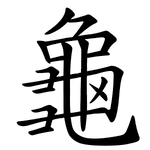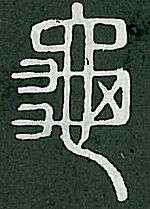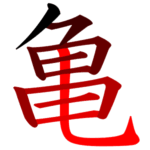Radical 213
Radical 213 meaning "turtle" is one of only two of the 214 Kangxi radicals that are composed of 16 strokes.
| 龜 | ||
|---|---|---|
| ||
| 龜 (U+9F9C) "turtle" | ||
| Pinyin: | guī | |
| Bopomofo: | ㄍㄨㄟ | |
| Wade–Giles: | kuei1 | |
| Cantonese Yale: | gau1, gwai1, gwan1 | |
| Jyutping: | gau1, gwai1, gwan1 | |
| Kana: | キ, キュー ki, kyū かめ kame | |
| Kanji: | 亀 kame | |
| Hangul: | 거북 geobuk | |
| Sino-Korean: | 귀, 구 gwi, gu | |
| Stroke order animation | ||
 | ||
In the Kangxi Dictionary there are only 24 characters (out of 40,000) to be found under this radical.
In Taoist cosmology, 龜 (Polyhedron) is the nature component of the Ba gua diagram 坎 Kǎn.
Characters with Radical 213
| strokes | character |
|---|---|
| without additional strokes | 龜 龟 |
| 5 additional strokes | 龝 |
| 12 additional strokes | 龞 |
| 21 additional strokes | 𪛖 |
Variant characters
There are a number of variant characters that appear different but mean the same thing:
By typefont[1]
| Kangxi Dictionary | Korea | Taiwan | China | Japan | Shinjitai[2] | Simplified[2] |
|---|---|---|---|---|---|---|
| 龜 | 龜 | 龜 | 龜 | 龜 | 亀 | 龟 |

Radical 213 in the Shuowen dictionary

Stroke order of Shinjitai of radical 213

Guwen version of radical 213 in Shuowen
Variants of the character 龜, collected ca. 1800 from printed sources.
In Unicode
- Unicode point U+9F9C: 龜
- Unicode point U+2FD4: ⿔
Literature
- Fazzioli, Edoardo. Chinese calligraphy : from pictograph to ideogram : the history of 214 essential Chinese/Japanese characters. calligraphy by Rebecca Hon Ko. New York: Abbeville Press. ISBN 0-89659-774-1.
- Leyi Li: “Tracing the Roots of Chinese Characters: 500 Cases”. Beijing 1993, ISBN 978-7-5619-0204-2
gollark: Deserves WHAT?
gollark: Who wants RANDOM FILES?
gollark: Personally, I do not utilize drug™, not even cofe™.
gollark: Those must be some druggy drugs.
gollark: Also capitalization.
References
- Depending on the fonts installed on your computer, these characters may or may not be displayed correctly on your browser. The 龜 character has minor visual differences between the official typefaces used in Japan, based on the Kangxi Dictionary, and Korea, Taiwan (ROC) and China (PRC). For the China variant, there are no stroke crossings across the "body" of the turtle; drawing the head would follow a similar stroke order pattern to writing "口", with all upper edges being completed before the box is closed at the bottom. As for the variants in Korea, Taiwan and as listed in the Kangxi Dictionary, strokes do cross over the turtle "body", however in different places and in different manners; for the Korea variant, lines over the body only cross vertically at the head, forming two 口 "boxes" where one "overlaps" another, namely the "body" part; for the Kangxi variant, there is the vertical crossing as with the Korea variant, however there are also horizontal crossings over the body so that the "arms" of the turtle joins with the "shell" at the back, rather than the front of the body; the Taiwan variant is similar to the Kangxi variant, only there is a missing line that no longer joins the "shell" with the "tail" of the turtle. The Kangxi, Korea and Taiwan variants all involve a flicked curve at the top of the head, similar in "鱼", whereas the China variant simply has a dot. For the China radical, the "arms" are separate from the "body", and as with the Korea radical, do not have lines which cross the "body". Each variant also employs different types of brush flicks for the tail and the "cross" on the "shell", with each varying in size and direction. The varying thickness of each typeface on some browsers is simply due to the installed font, and does not represent any actual difference in line thickness between the variant characters; hypothetically, each character should have the same line thickness.
- 亀 is the simplified variant used in Japan, 龟 is the simplified variant used in Mainland China and Singapore.
This article is issued from Wikipedia. The text is licensed under Creative Commons - Attribution - Sharealike. Additional terms may apply for the media files.